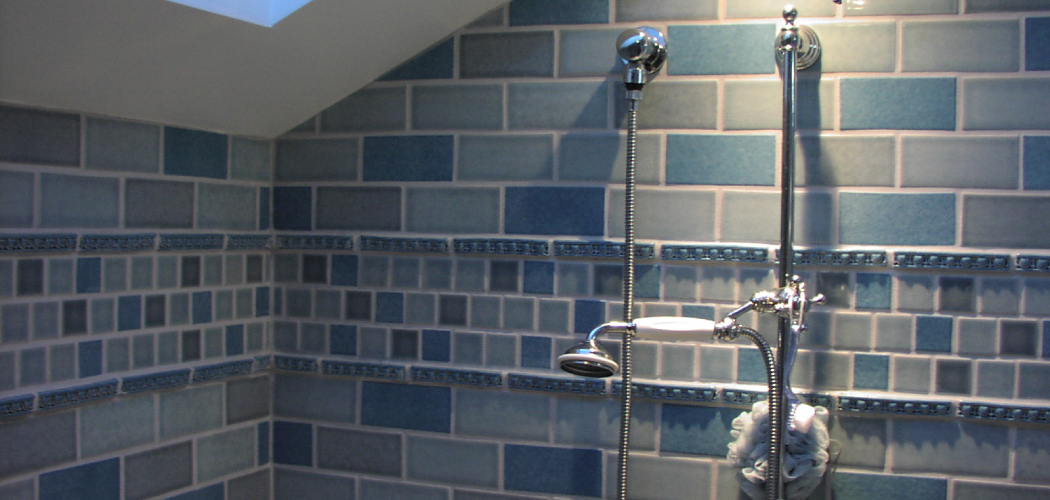If you’re tired of your bathroom tiles’ old and dull color, repainting them is a great solution to give them a fresh new look. However, what happens if you decide the new paint was not the right choice? Or it’s time for another change in your bathroom decor.
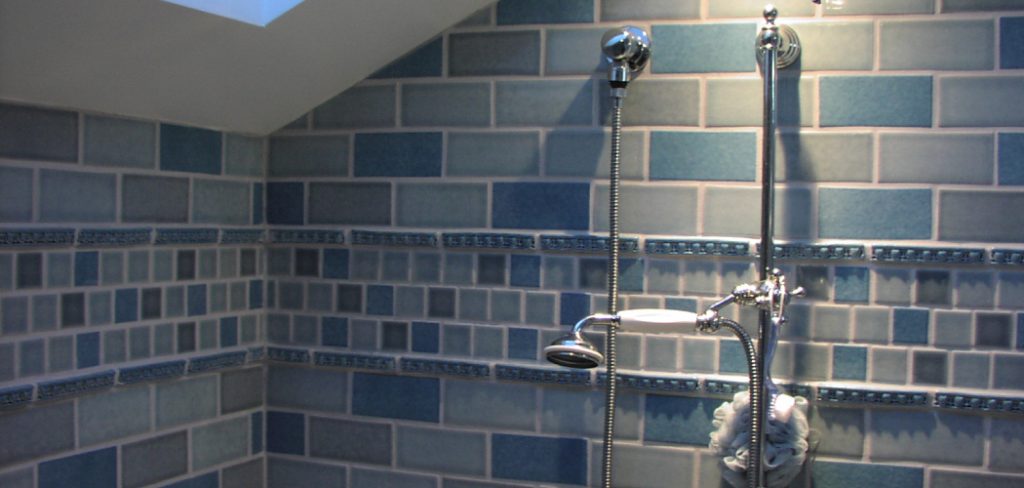
Removing tile paint from bathroom tiles can be daunting, but it is not impossible. In this guide, we will walk you through the methods on how to remove tile paint from bathroom tiles effectively. Let’s get started if you’re ready to give your bathroom a new canvas!
Understanding Tile Paint
Before we dive into the removal processes, it’s essential to understand what tile paint is and how it works. Tile paint is a type of specialty paint designed for use on tiles. It provides a durable and waterproof finish that can withstand constant exposure to water and moisture.
It comes in various colors and finishes, making it an attractive option for homeowners looking to update their bathroom tiles without the cost and hassle of replacing them. However, it’s important to note that not all tile paints are created equal, and some may be more difficult to remove than others.
Tools and Materials You Will Need to Remove Tile Paint From Bathroom Tiles
- Paint stripper or remover
- Protective gear (gloves, mask, and safety glasses)
- Scraper or putty knife
- Sponge
- Bucket of warm water
- Dish soap
- Sandpaper or sanding block
11 Best Methods on How to Remove Tile Paint From Bathroom Tiles
1. Chemical Paint Strippers:
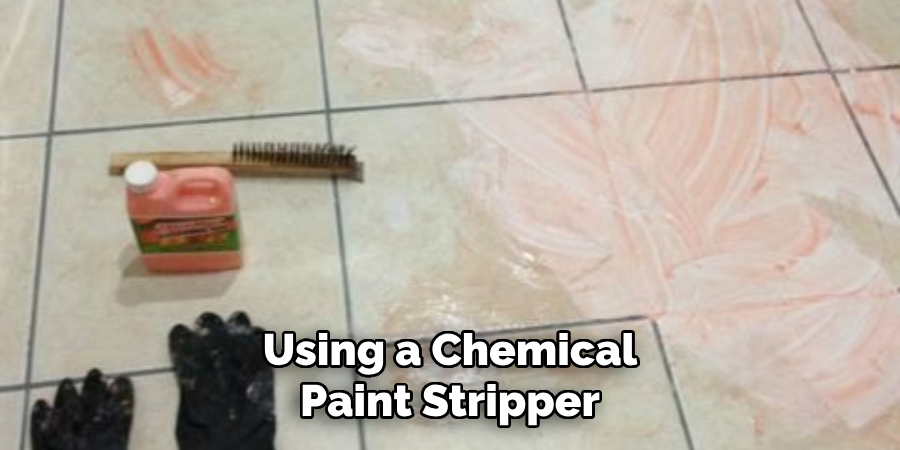
One of the most common and effective methods of removing tile paint is by using a chemical paint stripper. These products are specifically designed to dissolve and loosen paint from surfaces, making it easier to scrape off. However, they contain harsh chemicals that can be harmful if not handled carefully. Always wear protective gear when using these products. This method is best for removing multiple layers of paint or stubborn and hard-to-remove paint.
2. Using Heat Gun:
One alternative to chemical paint strippers is using a heat gun. This method uses high heat to soften and loosen the paint, making it easier to scrape off with a putty knife or scraper. It’s important to note that this method can be time-consuming and unsuitable for all types of tile paints. Using excessive heat can also damage the tiles, so be careful and use low heat settings.
3. Sanding Your Tiles:
Sandpaper or a sanding block can also be used to remove tile paint. This method is best for removing small areas of paint or touch-ups. It involves gently sanding the painted area until the top layer of paint is removed, but it may take some time and effort. Be sure to use fine-grit sandpaper and avoid using too much pressure, as it can scratch or damage the tiles. This method is not suitable for textured or uneven tiles.
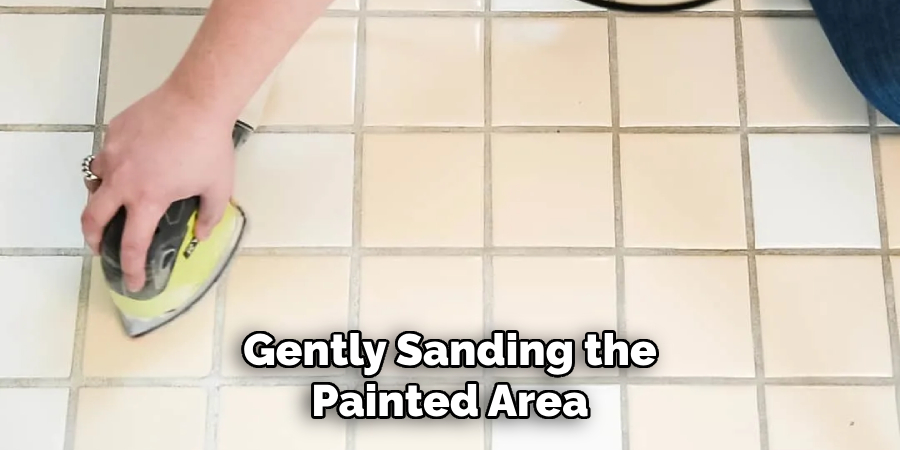
4. Steam Cleaning:
Using a steam cleaner can also be an effective method to remove tile paint from bathroom tiles. The hot steam helps loosen the paint, making it easier to scrape off with a putty knife or scraper. It’s a safe and eco-friendly option that doesn’t involve any harsh chemicals, but it may not be suitable for all types of tile paints. If the paint is not coming off easily, use a chemical paint stripper or heat gun instead.
5. Soapy Water and Scrubbing:
For small areas of paint or touch-ups, try using warm, soapy water and a scrub brush to remove the tile paint. This method may take some time and effort, but it’s a safe and gentle option that won’t damage your tiles. Mix dish soap and warm water in a bucket, then use a sponge or scrub brush to apply the solution to the painted area. Let it sit for a few minutes before gently scrubbing and rinsing off.
6. Using Acetone:
Acetone is a strong solvent that effectively removes paint from surfaces, including bathroom tiles. However, it is a harsh chemical and should be used with caution. Always wear protective gear and work in a well-ventilated area when using acetone to remove tile paint. This method is best for small areas or touch-ups rather than larger surfaces. Using too much acetone can damage the tiles, so use it sparingly.
7. Scraping With a Razor Blade:
For small areas of paint or touch-ups, you can use a razor blade to gently scrape off the paint. Hold the blade at a low angle and carefully scrape off the top layer of paint without damaging the tile surface. This method may take time and effort, but it is a safe and gentle option. This method is not suitable for textured or uneven tiles.
8. Using Paint Thinner:
Paint thinner is another solvent that can effectively remove paint from bathroom tiles. It’s important to note that this method may also strip off the tile’s original finish, so it should be used cautiously. Always wear protective gear and work in a well-ventilated area when using paint thinner. This method is best for removing small areas of paint or touch-ups.
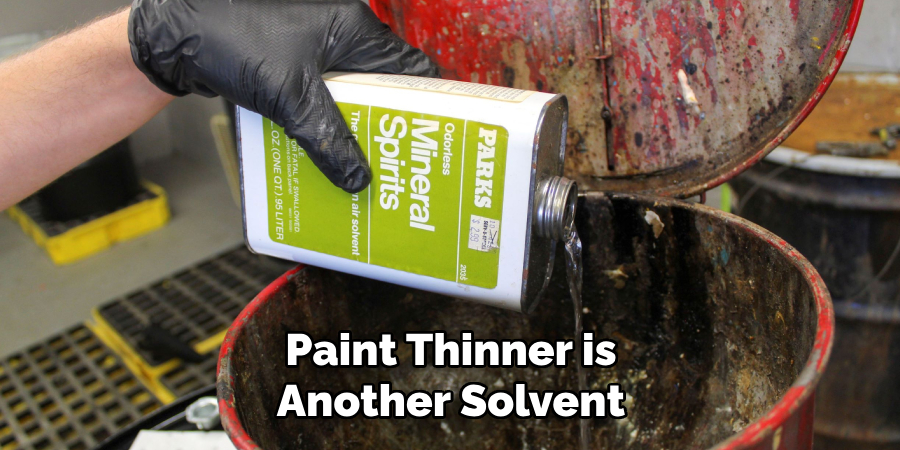
9. Vinegar Solution:
Vinegar is an excellent natural cleaner that can also be used to remove tile paint from bathroom tiles. Mix equal parts of vinegar and warm water in a spray bottle, then spray it onto the painted area. Let it sit for a few minutes before gently scrubbing and rinsing off. This method may not be as effective as other methods, but it’s a safe and eco-friendly option.
10. Using Pressure Washer:
If you have access to a pressure washer, this can also be an effective way to remove tile paint from bathroom tiles. The high-pressure water can effectively strip off the paint without damaging the tiles. However, this method should be used carefully and only on durable tiles. It’s also important to wear protective gear and avoid using excessive pressure, as it can damage the tile surface.
11. Professional Tile Paint Removal Services:
If you’re uncomfortable or confident removing tile paint yourself, hiring a professional tile paint removal service is best. They have the expertise and equipment to effectively remove tile paint without damaging your tiles. Although it may be a more expensive option, it guarantees a safe and hassle-free removal process. This is especially recommended for large and stubborn areas of paint.

Following these methods can help you successfully remove tile paint from your bathroom tiles without damaging them. Remember to always wear protective gear and work in a well-ventilated area when using harsh chemicals. If you need more clarification or are uncomfortable with any of these methods, it’s best to seek professional help. Removing any unwanted paint can keep your bathroom tiles looking clean and refreshed. Happy painting!
Additional Tips and Tricks to Remove Tile Paint From Bathroom Tiles

- If you are using a chemical cleaner, make sure to wear protective gear such as gloves and a face mask to avoid any contact with your skin or inhaling harmful fumes. If the cleaner gets on your skin, wash it off immediately with soap and water.
- To avoid damaging the tile surface, always follow the instructions from the chemical cleaner’s manufacturer. This includes diluting the cleaner according to its recommended ratio and applying it only for the specified amount of time.
- For an all-natural option, mix baking soda and water in equal parts to create a paste. Apply the paste onto the painted tiles and let it sit for about 15 minutes before scrubbing it off with a brush or sponge.
- If the paint still doesn’t come off, use a heat gun or hairdryer on the lowest setting to soften it. Then, use a plastic scraper or credit card to gently scrape off the paint. Be careful not to damage the tile surface.
- You can make a solution of equal parts vinegar and hot water for tough and stubborn paint stains. Spray or pour the solution onto the painted tiles and let it sit for about 30 minutes before scrubbing it off with a brush or sponge.
- As a preventative measure, always make sure to use a primer before painting bathroom tiles. This will help the paint adhere better and prevent it from peeling or chipping in the future.
- After removing the paint, thoroughly rinse the tiles with clean water and dry them with a soft cloth. You can also use a mild cleaner to remove any residue from the chemical cleaner or natural paste.
- To maintain the cleanliness and shine of your bathroom tiles, regularly clean them with a gentle cleaner and avoid using harsh chemicals or abrasive materials.
- If you are still determining which method to use for your type of tile, it is always best to consult a professional before attempting any DIY methods.
- Remember to take breaks while working on removing paint from bathroom tiles to avoid fatigue and strain. Always ventilate the room properly to prevent inhaling any fumes from chemical cleaners.
- Finally, keep going even if the paint doesn’t come off on the first try. Sometimes, multiple attempts may be required to remove all the paint from the bathroom tiles. Just be patient and persistent in your efforts.
Following these additional tips and tricks can help make removing paint from bathroom tiles much easier and safer. With patience and care, your tiles will look clean and fresh again. Remember to always take precautions when using chemical cleaners for your own safety. Happy cleaning!
Things You Should Consider to Remove Tile Paint From Bathroom Tiles
1. The first thing you should consider when removing tile paint from bathroom tiles is the type of paint used. Depending on the type of paint, different methods may be more effective in removing it. For example, oil-based paints may require a different approach than water-based paints.
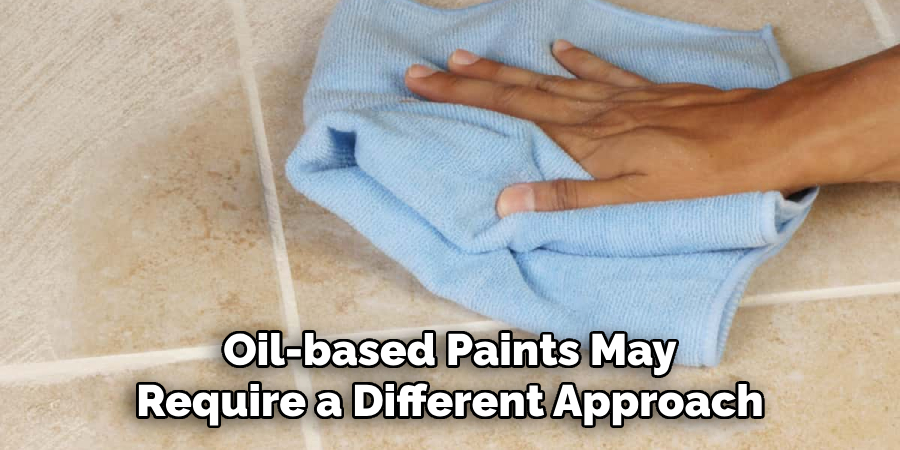
2. Another important factor to consider is the condition of your bathroom tiles. If the tiles are old and brittle, you must take extra care when removing the paint to avoid damaging them further. On the other hand, if the tiles are newer and in good condition, you may have more flexibility in your removal methods.
3. Before starting the paint removal process, protecting yourself and your bathroom from potential harm is important. This includes wearing protective gear such as gloves and goggles and laying down drop cloths or newspapers to catch any drips or spills.
4. One method of removing tile paint is by using a chemical paint stripper. These products contain strong chemicals that break down the paint, making removing it easier. However, they can be harsh and damage the tiles if left on too long. Be sure to follow the instructions carefully and work in a well-ventilated area.
5. Another option is to use a heat gun or hair dryer to soften the paint before scraping it off with a putty knife. This method may take longer and require more effort, but it can be a safer alternative to chemicals.
6. If the paint is stubborn and won’t come off with chemical or heat methods, you can try sanding it off using sandpaper or a power sander. This should only be done as a last resort, as it can damage the tiles if not done carefully.
7. Once most of the paint has been removed, you may need to do some touch-up work with a smaller brush or sponge to reach any crevices or corners. If there are any remaining stubborn spots, you can use paint thinner or mineral spirits to loosen and remove them.
8. After removing all the paint, it is important to thoroughly clean and rinse the tiles to remove any remaining chemicals or residue. You can use a mild soap and water solution for this, but be sure to test it on a small area first to ensure it doesn’t damage the tiles.
9. Once the tiles are clean and dry, you may need to apply a new coat of sealant or wax to protect them and give them a fresh look. This is especially important if the paint removal process has damaged or worn the tiles.
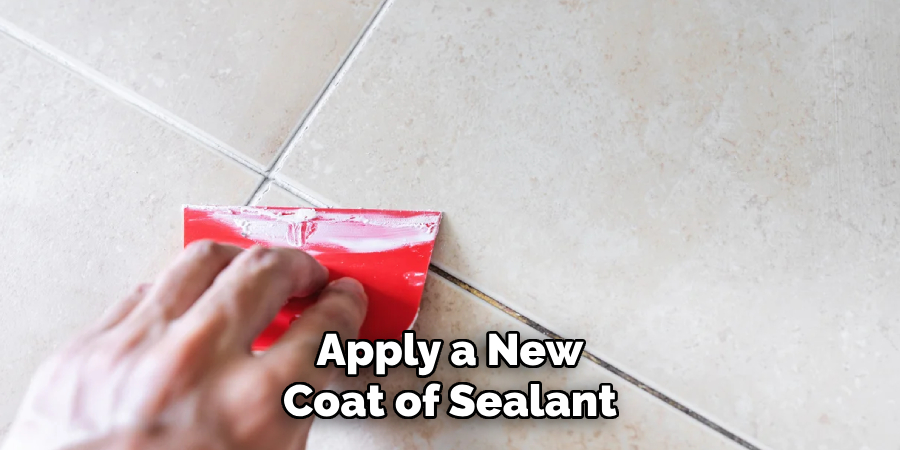
10. Finally, it’s always a good idea to do a spot test on a small, inconspicuous area before removing paint from your bathroom tiles. This will help you determine the best method for your situation and prevent potential damage or mistakes.
Following these considerations and taking necessary precautions can help ensure a successful and safe removal of tile paint from your bathroom tiles. Remember to always read and follow the instructions of any products used, and if you are unsure or uncomfortable with the process, it’s best to consult a professional for assistance.
With the right approach, you can transform your dull-painted tiles into beautiful, bare ones. So don’t be afraid to take on this DIY project and give your bathroom a fresh new look. Happy painting – or, in this case, unpainting!
Frequently Asked Questions
How Do I Know if My Tiles Have Been Painted?
If you suspect your bathroom tiles have been painted, there are a few tell-tale signs to look for. One of the easiest ways to identify painted tiles is by looking at the edges and corners of the tile. If you see any drips or unevenness in the paint, it clearly indicates that the tiles have been painted.
Another way to check if your tiles are painted is by looking at the grout lines. If there are any paint marks or discoloration in between the tiles, the tiles have likely been painted. You can lightly scratch the tile’s surface with a sharp object. If you see any paint flakes coming off, it’s a definite sign that your bathroom tiles have been painted.
Can I Remove Paint From My Bathroom Tiles?
Yes, it is possible to remove paint from bathroom tiles. However, the process can be time-consuming and requires careful handling as it can damage the tiles if not done correctly. The method of removing paint will depend on the type of tile and type of paint used. For example, ceramic tiles may react differently to paint stripper than porcelain tiles.
What If I Don’t Want to Use Harsh Chemicals on My Tiles?
If you want to avoid using harsh chemicals, you can try a few alternative methods. One method is to use heat to soften the paint and then scrape it off with a putty knife. Try using a baking soda paste or vinegar and water to help loosen the paint. Additionally, you could use a steam cleaner to remove the paint. However, remember that these methods may not be as effective as chemical strippers.
What Safety Precautions Should I Take When Removing Paint From Tiles?
Taking certain safety precautions is important when working with chemicals or solvents. Wear protective gloves, a mask, and safety goggles to prevent contact with your skin or inhalation of fumes. Also, make sure the room is well-ventilated while you work. If you use a chemical stripper, follow the instructions carefully and avoid getting it on any surrounding surfaces.
How Can I Restore My Tiles After Removing Paint?
Once you have successfully removed the paint, you may notice that your tiles look dull or have lost their shine. To restore them, use a tile cleaner and gently scrub the surface. You could also apply a coat of sealant to protect the tiles from future damage. If there are any small scratches or chips in the tiles, you can fill them with grout or touch-up paint for a seamless finish. With proper care and maintenance, your bathroom tiles will look as good as new!
Conclusion
Knowing how to remove tile paint from bathroom tiles is essential for any homeowner or renter. By identifying the signs of painted tiles and following proper removal techniques, you can successfully restore your tiles to their original condition.
Remember to always take safety precautions when working with chemicals, and don’t hesitate to seek professional help if needed. With a little bit of effort and patience, you can have a beautifully updated bathroom without the hassle of painted tiles. So next time you come across painted bathroom tiles, you’ll know exactly what to do! Happy cleaning!

